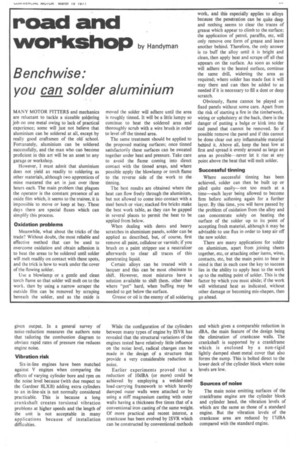road and
Page 35

If you've noticed an error in this article please click here to report it so we can fix it.
workshop by Handyman
Bench wise: you can solder aluminium
MANY MOTOR FITTERS and mechanics are reluctant to tackle a sizeable soldering job on one metal owing to lack of practical experience; some will just not believe that aluminium can be soldered at all, except by really good craftsmen of the old. school. Fortunately, aluminium can be soldered successfully, and the man who can beedme proficient in this art will be an asset to any garage or workshop.
However, I must admit that aluminium does not yield as readily to soldering as other materials, although two apprentices of mine mastered the art in just over three hours each. The main problem that plagues the operator is the constant presence of an oxide film which, it seems to the trainee, it is impossible to move or keep at bay. These days there are special fluxes which can simplify this process.
Oxidation problems Meanwhile, what about the tricks of the trade? Without doubt, the most reliable and effective method that can be used to overcome oxidation and obtain adhesion is to heat the areas to be soldered until solder will melt readily on contact with these spots, and the trick is how to work under the cover of the flowing solder.
Use a blowlamp or a gentle and clean torch flame so that solder will melt on to the work, then by using a narrow scraper the outside film can be removed by scraping beneath the solder, and as the oxide is moved the solder will adhere until the area is roughly tinned. It will be a little lumpy so continue to heat the soldered area and thoroughly scrub with a wire brush in order to level off the tinned area.
The same treatment should be applied to the proposed mating surfaces; once tinned satisfactorily these surfaces can be sweated together under heat and pressure. Take care to avoid the flame coming into direct contact with the tinned areas, and where possible apply the blowlamp or torch flame to the reverse side of the work to the • tinning.
The best results are obtained where the heat can flow freely through the aluminium, but not allowed to come into contact with a steel bench or vice; stacked fire bricks make the best work table, as they can be gapped in several places to permit the heat to be applied from below.
When dealing with dents and heavy scratches in aluminium panels, solder can be applied as described, but, of course, first remove all paint, celluloseear varnish; if you brush on a paint stripper use a neutralizer afterwards to clear all traces of this penetrating liquid.
Certain alloys can be treated with a lacquer and this can be most obstinate to shift. However, most mixtures have a solution available to shift them. other than where "pot" hard, when buffing inay be needed to get below the surface.
Grease or oil is the enemy of all soldering
work, and this especially applies to alloys because the penetration can be quite deep and nothing seems to clear the traces of grease which appear to climb to the surface; the application of petrol, paraffin, etc, will only remove one form of grease and leave another behind. Therefore, the only answer is to buff the alloy until it is bright and clean, then apply heat and scrape off all that appears on the surface. As soon as solder will adhere to the heated Surface, continue the same drill, widening the area as required; where solder has made fast it will stay there and can then be added to as needed if it is necessary to fill a dent or deep scratch.
Obviously, flame cannot be played on fixed panels without some care. Apart from the risk of starting a fire in the timberwork, wiring or upholstery at the back, there is the danger of putting a bulge or kink into the tied panel that cannot be removed. So if possible remove the panel and if this cannot be done clear out any inflammable material behind it. Above all, keep the heat low at first and spread it evenly around as large an area as possible—never let it rise at any point above the heat that will melt solder.
Successful tinning Where successful tinning has been achieved, solder can then be built up or piled quite easily—not too much at a time—each layer being allowed to become firm before softening again for a further layer. By this time, you will have passed by the problem of oxidationfrom the alloy and can concentrate solely on heating the surface of the solder up to its point of accepting fresh material, although it may be advisable to use flux in order to keep air off the new solder.
There are many applications for solder on aluminium, apart from joining sheets together, etc, or attaching other items, wires, contacts, etc, but the main point to bear in mind is that in each case the key to success lies in the ability to apply heat to the work up to the melting point of solder. This is the factor by which you must abide; if the work will withstand heat as indicated, without other damage or becoming mis-shapen, then go ahead.




























































































